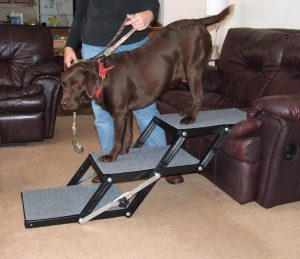1. If you want to teach your dog “Right” and “Left,” first be sure you know your right from your left!
Some people teach the commands and the dogs learn them very well, then the handler gets confused and gives the dog the wrong direction command on the course. If you are sure you want to teach directionals, and you can remember that the dog will turn to his right or left, regardless of which direction you are facing, and then teach them. One way to begin is with simple spins. You can lure your dog to turn right and left with a cookie in your hand: tell the dog “right” and use the cookie to turn the dog to the right in a small circle. Do the same for the left side, but first only work one direction at a time, then when each direction seems solid on its own, start proofing them by mixing up a right and left command. You can also teach this with a wrap around a jump, indicating to the dog to go over the jump in front of him and then turn to his right or left to wrap around the jump.
2. You can also use a “right” and “left” to indicate the end of a tunnel you want your dog to take.
You can tell the dog “right tunnel” or “left tunnel” when you are heading towards a “C” shaped tunnel and you want the dog to enter at a specific side. You can begin by repeating “left tunnel” command while using your body and hand signals to indicate that end of the tunnel to your dog in practice. Do the same for the right side of the tunnel. It may be easier to start with basic right/left directionals as discussed in #1 above, then move on to tunnel entry discriminations. Eventually, fade the body language so that you can send the dog to either end of the tunnel without running there yourself. This can be helpful for training gambles.
3. “Go” and “Out” are often used on a course, with varying results from different handlers.
Keeping consistency in mind, you can use “go” to mean “continue moving directly ahead in a continuous line,” such as a straight line of jumps. You can use “out” to mean “move laterally away from me,” meaning that the dog will move away from your body, to your right or left, depending upon which side the dog is starting from. For example, you might be running parallel to a line of jumps that are on your right-hand side in a serpentine, and “out means for the dog to take the jump by jumping away from your right side while you continue forward. If you use these commands, don’t mix them up so that sometimes out means move laterally away and sometimes it means go ahead (as many handlers do on course) or the commands will cease to have meaning for the dog.
4. The “Turn” or “Switch” command can mean two different things to handlers, either “turn away from me” or “change leads.”
If you have “right” and “left” commands, or an “out” command, then it is easy to be consistent with having “turn” or “switch” signal a lead change to the dog. This is helpful when you are crossing behind the dog and changing direction. For example, if the dog is going through a pinwheel that is turning to the left, he is likely on a left lead (the left front foot is moving further ahead than the right and is leading). If you need to move out of the pinwheel and turn to the right while crossing behind your dog, a “turn” command can signal the dog to change to a right lead and turn towards the right. This command can be handy in many different situations on a course.
5. Obstacle discriminations are helpful when the dog has a choice between two closely positioned obstacles.
The most common is a tunnel/contact discrimination, such as a tunnel that goes under an A-frame or a dog walk, or a jump/tunnel discrimination when a jump and tunnel opening are very close together. Many dogs will “tunnel suck” into the tunnel, so discriminations can be helpful. Initially, we train our dogs to do each obstacle and we assign a command to that obstacle; with obstacle discriminations, we test our dog’s knowledge of the verbal command associated with the obstacle, along with how well our dog listens and responds to what we ask of him. After your dog has a firm understanding of how to perform each obstacle successfully, you may begin placing the two obstacles you want to differentiate closer and closer to each other, while asking the dog to take one or the other. For example, you can place the tunnel opening a few feet from the A-frame, and over time as you practice, move it closer and closer to the A-frame until they are immediately next to each other. In practice, you can be closer to your dog than you might be on a full course and you can use body language to indicate the proper obstacle, but as you work on the discrimination, use less body language until you are able to send your dog to the tunnel versus the dog walk, or the jump versus the tunnel, etc. This is also helpful in practicing sends for gambles.








